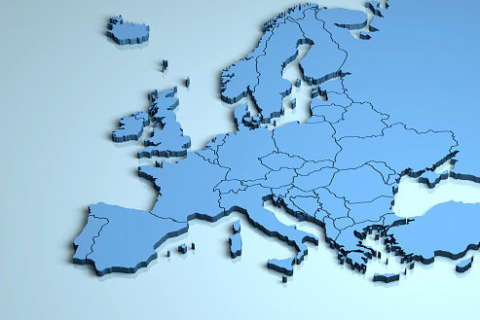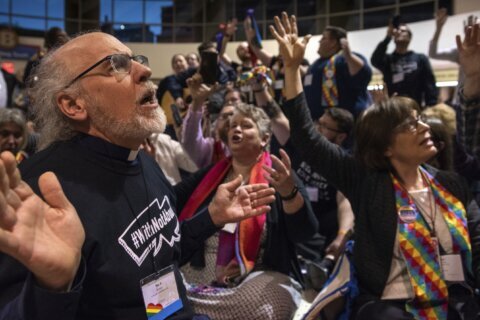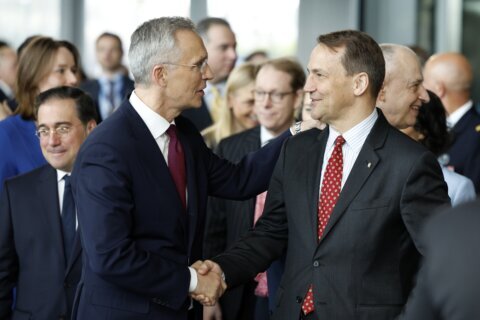DAVOS, Switzerland (AP) — If you’re coming to Davos this year, try to take the train instead of flying, organizers of the World Economic Forum said.
So I did.
That meant a 12-hour journey from London to the exclusive gathering in the Swiss Alps, which I’m helping cover for The Associated Press.
Taking a train is much less convenient than a plane, but the scenery made up for it — the rolling farm fields of England and France gave way to Switzerland’s towering mountains and idyllic valleys dotted with chalets. And my carbon footprint will be a lot lower than a flight.
To many, Davos conjures up images of government leaders, billionaire elites and corporate titans jetting in on carbon-spewing private planes even as the meeting increasingly focuses on climate change.
Organizers have been stung by such criticism, even dedicating a webpage in past years to debunk those claims. Encouraging European attendees to come by train is part of their efforts to burnish the event’s sustainability credentials amid criticism it’s merely a talking shop that doesn’t produce systemic change.
I’m not the first to go by train. Swedish climate activist Greta Thunberg famously took a 32-hour train ride to get to the Davos meeting in 2019, where she astonished participants with a fiery speech. I’m also riding a broader wave of traveler interest in train trips over short-haul flights tied to climate guilt.
My journey begins at London’s St. Pancras International train station, where I board the high-speed Eurostar that whisks me through a tunnel under the English Channel to Paris in about two and a half hours. There I take a short metro ride to another train station for the next four-hour leg to Zurich.
By plane, I would have been crammed on a discount flight from London’s Gatwick Airport for the hour and 40-minute flight to Zurich, the closest airport to Davos.
But for those who don’t live in Europe, a plane ride is unavoidable. And to speed up my trip after days of back-to-back speeches from government leaders and sessions about decarbonization, the global economic outlook and the impact of Russia’s war in Ukraine, that’s how I’ll be traveling home.
Aboard the French high-speed TGV train, the first-class seats are comfy and spacious and the upper deck view offers pleasant scenes of the countryside whizzing by at 320 kilometers an hour (about 200 mph).
If I had flown, my 870-kilometer trip would have emitted up to 197 kilograms (434 pounds) of carbon dioxide per passenger into the atmosphere.
The same trip by train would contribute a fraction of that amount — 12.2 kilograms, according to ecopassenger.org.
World Economic Forum officials say climate is a priority for this year’s meeting and tout its green credentials.
“The overwhelming majority of participants arrive by shuttle or by train, and emissions in Davos actually go down during the week of the meeting,” forum Managing Director Adrian Monck told reporters ahead of the event, without elaborating.
Organizers say that since 2017 they have offset 100% of the carbon emissions from the group’s activities by supporting environmental projects in Switzerland and elsewhere. Experts say offsets can be problematic because there’s no guarantee they’ll deliver on reducing emissions.
The forum also can provide sustainable jet fuel at Zurich’s airport for those who take private jets.
“It’s probably one of the most sustainably organized meetings in the world, if not the most sustainable,” Monck said.
High-profile attendees include U.S. climate envoy John Kerry, Ugandan climate activist Vanessa Nakate and Alok Sharma, head of last year’s U.N. climate conference, COP26.
Kerry, who has been criticized for his use of a private jet belonging to his wife’s family, will be traveling by commercial plane to the Davos meeting, his spokesperson said.
Sharma, a British lawmaker who drew flak last year for his frequent flights, will travel by plane and train.
“Carbon emissions associated with the COP President’s travel will be offset for the Presidency year,” the U.K. government said, without providing further details.
Nakate declined to comment on her travel.
Aviation accounts for about 2% of global carbon emissions.
The World Economic Forum has acknowledged that “from an environmental perspective, taking a private jet is the worst way to travel to Davos.”
Private jets emit about 10 times the carbon dioxide per person that commercial flights do and about 50 times more than an equivalent train journey, said Jo Dardenne, aviation manager at Brussels-based climate policy group Transport & Environment.
Jet engines also spew soot and nitrous oxide, which contributes to pollution around airports and heat-trapping atmospheric contrails, she said.
Sustainable jet fuel is a step in the right direction, depending on the source, but carbon offsetting deserves more skepticism because of concerns such as double counting, she said.
“It’s just especially a bit socially and politically unfair for some sectors to continue to rely on offsetting instead of actually reducing their emissions,” while others face pressure to reduce their climate impact, Dardenne said.
Eymeric Segard, CEO of Swiss private jet chartering company LunaJets, said some VIPs have no other choice than to fly private.
“Because of their visibility and fact that everybody knows them, they just cannot take a commercial aircraft,” he said.
“Some don’t have three weeks free to take sailboats to cross the Atlantic like our friend Greta. So what’s the alternative?”
Segard declined to discuss how much demand he’s seeing for travel to Davos but said his company, which acts like a taxi dispatcher for private jets, tries to reduce carbon emissions by looking for “empty leg flights,” which have already been chartered but have extra seats.
Not only is it cheaper but “the planet is happy because anyway the plane was gonna fly, so at least we put someone on it,” he said.
From Zurich’s main train station, I change again, this time boarding a slower local train. This is where most people can’t avoid rail as they head to Davos, which doesn’t have an airport, unless they take a shuttle or helicopter from Zurich or two other small nearby airports.
Fashionably dressed people hauling expensive-looking luggage climbed aboard, mentioning to others what panels they’re part of in Davos.
The train skirts Lake Zurich and heads into the mountains. After another quick change at a local station, I’m down to my last hour, and the scenery becomes more impressive with each mile.
The narrow-gauge train trundles through steep valleys and alongside whitewater rivers, overshadowed by forested peaks with chalets scattered on grassy lower slopes until arriving in Davos. Here my journey ends but my work for the week begins.
___
Kelvin Chan is an AP business writer in London. Follow him at http://twitter.com/chanman.
Copyright © 2024 The Associated Press. All rights reserved. This material may not be published, broadcast, written or redistributed.







